Decades of studies from respected academic institutions, have demonstrated significant impacts of porn consumption for individuals, relationships, and society. "What’s the Research" aims to shed light on the expanding field of academic resources that showcase porn’s harms in a variety of ways. Below are selected excerpts from published studies on this issue.
The full study can be accessed here.
Neuroscience of Internet Pornography Addiction: A Review and Update
Authors: Todd Love, Christian Laier, Matthias Brand, Linda Hatch, and Raju Hajela
Published: September 2015
Peer-Reviewed Journal: Behavioral Sciences
Abstract
Many recognize that several behaviors potentially affecting the reward circuitry in human brains lead to a loss of control and other symptoms of addiction in at least some individuals. Regarding Internet addiction, neuroscientific research supports the assumption that underlying neural processes are similar to substance addiction.
The American Psychiatric Association (APA) has recognized one such Internet-related behavior, Internet gaming, as a potential addictive disorder warranting further study, in the 2013 revision of their Diagnostic and Statistical Manual.
Other Internet-related behaviors, e.g., Internet pornography use, were not covered. Within this review, we give a summary of the concepts proposed underlying addiction and give an overview about neuroscientific studies on Internet addiction and Internet gaming disorder. Moreover, we reviewed available neuroscientific literature on Internet pornography addiction and connect the results to the addiction model.
The review leads to the conclusion that Internet pornography addiction fits into the addiction framework and shares similar basic mechanisms with substance addiction. Together with studies on Internet addiction and Internet Gaming Disorder we see strong evidence for considering addictive Internet behaviors as behavioral addiction.
Future research needs to address whether or not there are specific differences between substance and behavioral addiction.
Background
A revolutionary paradigm shift is occurring in the field of addiction that has great implications for assessment and treatment. While “addiction” has historically been associated with the problematic overconsumption of drugs and/or alcohol, the burgeoning neuroscientific research in this field has changed our understanding over the last few decades.
It is now evident that various behaviors, which are repeatedly reinforcing the reward, motivation and memory circuitry are all part of the disease of addiction. Common mechanisms among addiction involving various psychoactive substances such as alcohol, opioids and cocaine; and pathological behaviors such as uncontrolled gambling, internet use, gaming, pornography and sexual acting out have also been delineated.
As a result of the growing neuroscientific evidence, the American Society of Addiction Medicine (ASAM) formally expanded its definition of addiction in 2011 to include both behaviors and substances:
“Addiction is a primary, chronic disease of brain reward, motivation, memory, and related circuitry. Dysfunction in these circuits leads to characteristic biological, psychological, social, and spiritual manifestations. This is reflected in an individual pathologically pursuing reward and/or relief by substance use and other behaviors.”
Methods
To conduct the research, an extensive literature search and review was performed utilizing a variety of sources: Multiple EBSCO collections (including ERIC, LISTA, PsychARTICLES, PsychEXTRA, PsychINFO, Psychology and Behavioral Sciences and SocINDEX), Google Scholar, PubMed and multiple ProQuest collections (including Central, Dissertations and Thesis, Psychology and Social Science).
A universal inclusion criterion was a publication in a peer-reviewed journal. A secondary inclusion criterion was based on publication date, with differing time-delimitations set based on the specific topic/category being investigated (see details below). Continuous rechecks of the more rapidly emerging subject areas (e.g., Internet-related addictions) were performed in an effort to remain current with the expanding body of knowledge.
As such, an exact number of results reviewed was impossible to calculate as the rechecks often returned results already reviewed. Some manual screen of ambiguously titled papers was required (performed by first author). Additionally, articles on treatment, etiology, psychopathology, comorbidity, or other counseling/psychological concerns regarding Internet-related addictions were eliminated, as were articles regarding Internet-related addictions as a societal or sociological issue….
Research into the area of addictive sexual behaviors on the Internet began with an inquiry into the various constructs surrounding compulsive sexual behavior.
There was no specific time-delimitation for this search, however, as with behavioral addiction, analytical priority was placed upon literature reviews and articles published via a newest to oldest methodology. The following search terms and their derivatives were used in multiple combinations: “Compulsive sex,” cybersex, hypersexual, “hypersexual disorder,” imaging, “impulsive sex,” neurobiolog*, “out of control sex,” “problem* sex*,“ sex, “sex addict*,“ “sexually explicit material,” and “visual sexual stimuli.”
There was no time scope placed upon the research into the area of IPA [internet pornography addiction], although a large amount of manual screening was required, as many results were articles about Internet pornography (IP) but focused on sub-topics unrelated to addictive/compulsive/problematic usage (e.g., content analysis, feminism, freedom of speech, morality concerns, societal impact, etc.).
Additional screening was required to differentiate articles about IP (included) and non-IP (not included). Multiple combinations of the following search terms and their derivatives were used: Porn* (to allow for porn, pornographic, and pornography), addict*, compulsive, cyber, imaging, Internet, neurobiol*, online, problem*.
Results
This review investigated the current body of scientific knowledge regarding neural processes of addiction in relation to both broad areas of psychoactive substances and behaviors such as gambling, sex, and internet use, as well as the available research supporting specific behavioral aspects and their subtypes.
Most of the studies used neuroimaging measures, EEGs, or physiological measurements, although some studies used neuropsychological measures. The common thread was that they all used neural data to tie addiction involving behaviors Internet-related manifestation of addiction (and the subtypes) in particular, to the well-established neuroscience on “substance abuse.”
The net result of this inquiry yielded a very large number of neuroscience-based studies that support the application of the addiction model to addictive Internet-related behaviors….
This review presents strong neuroscientific evidence for viewing internet-related behaviors, including IP [internet pornography] use, as potentially addictive, which should be taken into consideration when discussing the classification of IPA [internet pornography addiction].

